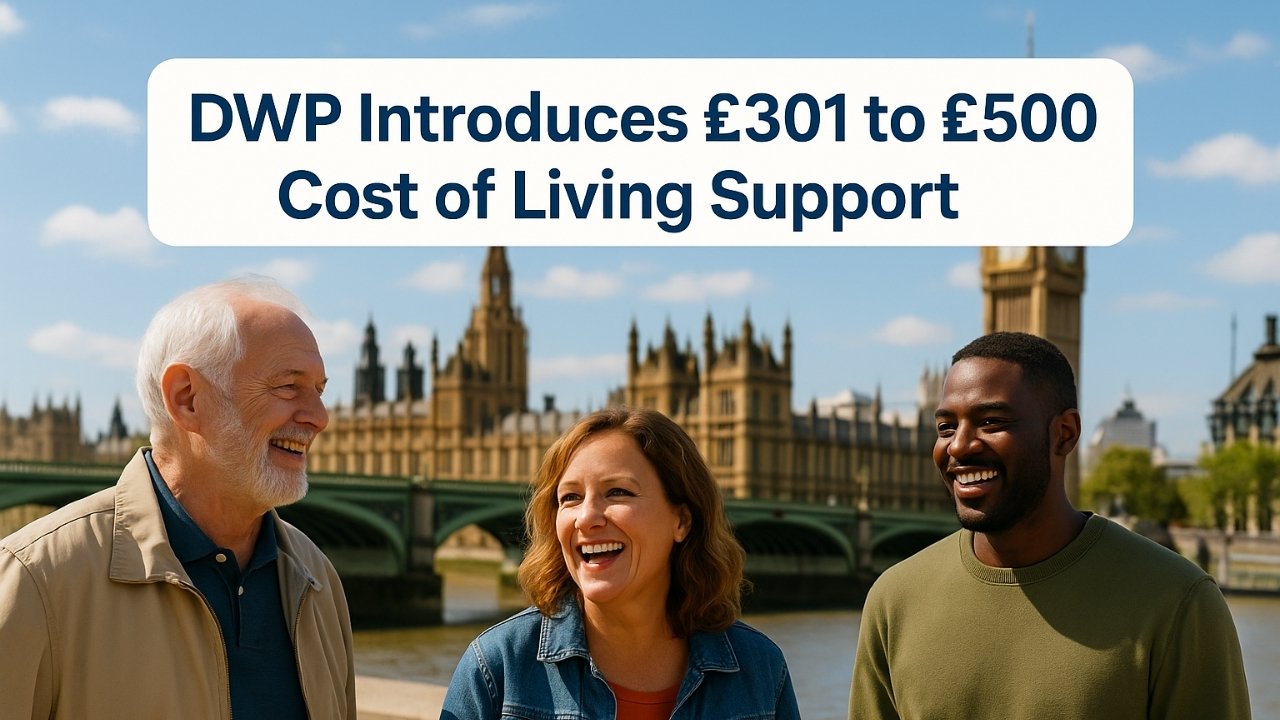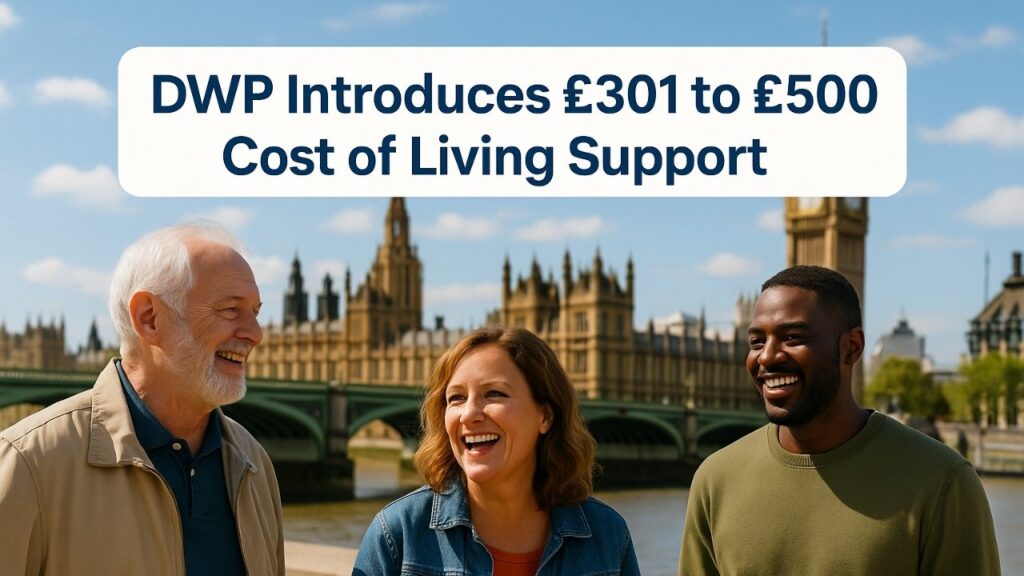The UK government has introduced a fresh series of Cost of Living Payments for 2025, led by the Department for Work and Pensions (DWP). These payments are designed to provide direct financial relief to low-income individuals, pensioners, carers, and disabled citizens. The total support will range from £301 to £500, distributed in a staggered manner throughout the year.
With inflation having remained above 6% for much of 2024 and energy prices continuing to pressure household budgets, this initiative serves as a crucial lifeline for millions. DWP estimates that over 8 million households will benefit from these payments, which are being automatically credited to eligible accounts.
Unlike one-off payouts from previous years, the 2025 plan adopts a multi-phase structure, allowing households to manage expenses more evenly across seasons, particularly during winter heating periods and summer childcare breaks.
Phased Payment Design to Spread Support Across the Year

The 2025 Cost of Living Payment strategy is designed to align support with seasonal needs and rising costs, offering a more responsive and continuous form of relief. Recipients will receive these payments automatically, provided they meet the eligibility requirements during the assessment periods set by the DWP.
| Period | Payment Window | Amount Disbursed |
|---|---|---|
| Spring Payment | March to May 2025 | £301 |
| Summer Payment | July to August 2025 | Up to £200 |
| Autumn Adjustment | October to December 2025 | Total up to £500 |
Each phase has its eligibility cut-off date, which the DWP will communicate to beneficiaries in advance. No application is needed, and payments will be made via the same method used for current benefits.
This approach avoids backloading financial relief and ensures that those in need receive assistance at critical points of the year when expenses typically spike.
Qualifying Benefits and Assessment Criteria
To receive the Cost of Living Payments, individuals must have been receiving specific means-tested benefits or tax credits during designated qualifying periods. These periods are generally announced in advance and verified through DWP or HMRC systems.
- Universal Credit
- Pension Credit
- Income-Based Jobseeker’s Allowance (JSA)
- Income-Related Employment and Support Allowance (ESA)
- Income Support
- Child Tax Credit
- Working Tax Credit
- Housing Benefit
Eligibility will be assessed automatically based on records. In most cases, receiving just one of these benefits is sufficient to qualify, though payment amounts may vary depending on household composition and need category.
Additional Support for High-Need Groups
The DWP recognizes that some recipients face more complex challenges. Those with disabilities, long-term illnesses, or those caring for others may incur higher monthly expenses, especially related to energy consumption and medical supplies.
| Recipient Type | Approximate Payment Range |
|---|---|
| Single Adult on Universal Credit | £301–£400 |
| Disabled Individual on PIP and ESA | £400–£500 |
| Pensioner with Attendance Allowance | £350–£500 |
| Household with Carer’s Allowance | £301–£450 |
Energy-intensive households using equipment such as oxygen concentrators or dialysis machines may be placed in the higher range. While the standard payment cap is £500, complementary schemes may further increase total yearly relief.
Direct Deposit and Verification of Information
The success of these payments depends heavily on the accuracy of claimant records. Since the funds will be directly deposited into existing benefit-linked accounts, it is essential that beneficiaries ensure their contact and bank details are current in the DWP and HMRC systems
- Log in to your DWP/HMRC account and check your current benefit status and bank account information.
- Update your contact details if you have recently changed addresses, mobile numbers, or financial institutions.
- Monitor SMS/email notifications from the DWP to stay aware of payment windows and eligibility confirmations.
- Contact the DWP helpline immediately if payments do not arrive within the announced timeframes.
Failure to maintain updated details may result in delayed or missed payments, requiring manual claim rectification.
Broader Importance of These Payments for UK Families
The importance of these payments extends beyond the short-term relief. Data from the Office for National Statistics (ONS) shows that nearly 25% of UK households were unable to afford essential heating or food in late 2024. Families on benefits are particularly vulnerable, as they often face static income amid rising living costs.
For example, a family on Universal Credit with two children spends over £350/month on groceries, and approximately £180/month on utilities during winter. These payments help such households cover immediate shortfalls without resorting to debt.
Pensioners, especially those living alone, benefit from these payments to meet increasing healthcare costs and nutrition expenses. Similarly, disabled individuals or households with chronic patients can utilize the relief to power medical equipment or access paid care services.
Additional Avenues for Financial Relief in 2025
Beyond the DWP’s Cost of Living Payments, other support schemes remain active and accessible. These programmes target various categories of need, and many can be used alongside the DWP assistance.
The Warm Home Discount Scheme is available to qualifying households and provides an automatic £150 reduction on energy bills. Likewise, the Household Support Fund is administered locally and covers emergency needs such as food vouchers, fuel tokens, or short-term accommodation support.
Furthermore, pensioners are eligible for Winter Fuel Payments, which range between £250 and £600, depending on age and circumstances. During extreme winter conditions, the Cold Weather Payment also activates, granting £25 per week when temperatures drop below freezing for seven consecutive days.
Together, these schemes offer a layered safety net that bolsters the DWP’s central offering.
A Timely Lifeline for Millions
The £301 to £500 Cost of Living Payments in 2025 come at a critical juncture. Rising prices, economic stagnation, and increased utility costs have placed immense strain on millions of households. The DWP’s structured payment rollout not only provides targeted relief but also reinforces the government’s commitment to shielding the most vulnerable.
By ensuring eligibility is clearly defined and disbursements are automatic, the program reduces the administrative burden on recipients. The inclusion of high-need individuals and families reflects a more inclusive and needs-responsive welfare strategy for the year ahead.
As economic pressures evolve, staying informed and proactive remains key. Eligible individuals are advised to review their benefit accounts, verify their details, and explore complementary support options through local councils and energy providers.



